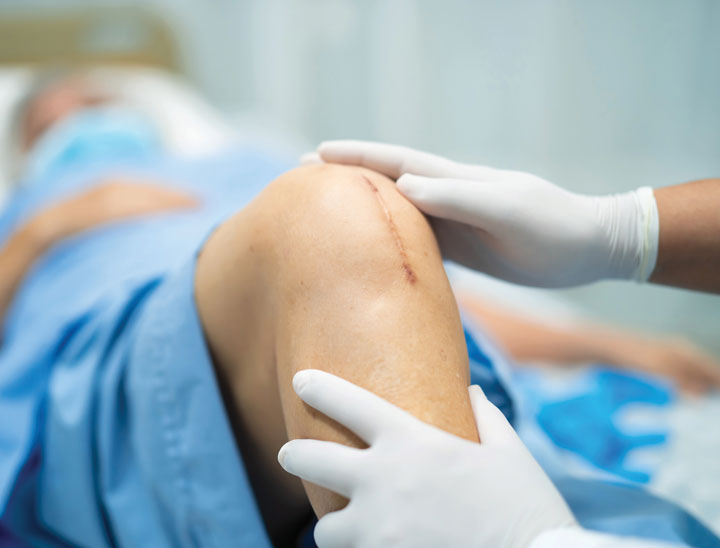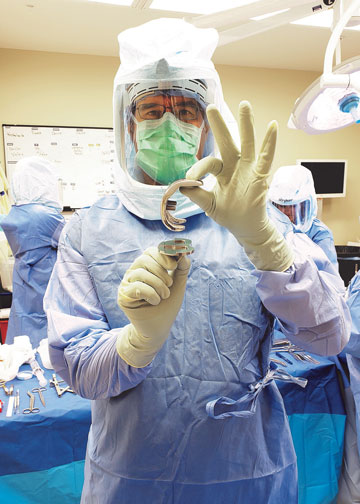- Home
- Article
Navigating Knee Revision Surgery
By: Kendal Kloiber | Contributing Editor
Published: 5/1/2024
Are you ready to add these complex cases at your facility?
Knee revision might sound a lot like knee replacement surgery, but the procedure entails a higher degree of complexity that demands specialized knowledge, tools and techniques that extend beyond the scope of routine orthopedic care.
“Knee revision surgery is very heterogeneous,” says Yale A. Fillingham, MD, a surgeon at Rothman Orthopaedic Institute in Bryn Mawr, Pa. “In comparison, primary knee replacement is a more homogenous procedure — yes, there might be some differences in the state of the disease and deformity, but by and large, we’re doing the same thing 99% of the time. However, in knee revision surgery, what we do can be incredibly wide ranging — it can go from just swapping out a piece of plastic to taking everything out and rebuilding the knee.”
The success of knee revision surgeries hinges not only on the technical proficiency of the surgeon but also on a robust support infrastructure and strategic planning to underpin these intricate interventions. That’s why the majority of revision cases are performed in a hospital setting, says Dr. Fillingham.
However, some surgeons are looking to take certain revision cases to outpatient settings, says David Crawford, MD, medical director of the Joint Implant Surgeons (JIS) Research Institute, who performs revision cases at his ASC Walnut Creek Surgical Suites in Gahanna, Ohio. While the ASC setting is not for every revision case, some cases are appropriate as their demand continues to escalate. However, if you’re thinking about adding revisions at your facility, experts warn you must approach these complex cases with precision and diligence.
Anticipating challenges

In knee revision surgery, the challenges are multifaceted, reflecting the diverse nature of the procedures involved. Unlike primary knee replacement, which typically follows a more standardized approach, knee revisions encompass a wide spectrum of interventions. From simply replacing a component to completely rebuilding the knee, the variability in procedures often poses the biggest challenge, says Dr. Fillingham.
“Every revision surgery you go in with plan A, B, C and D available to you,” he says. “The issue could be one that you couldn’t see on the imaging beforehand, so you have to be prepared for that. You might think it’s just exchanging a plastic piece, but once you get in there and you find the femur implant is loose, you’ll have to now revise that in addition to swapping out the plastic piece.”
This also means that surgeons need to approach revisions with the idea of ensuring thoroughness in addressing any underlying issues while also minimizing surgical trauma to the area. This delicate balance requires meticulous planning and the ability to adapt to unforeseen complexities during the procedure. Despite advancements, knee revision surgeries remain inherently invasive, often necessitating comprehensive interventions tailored to each patient’s unique circumstances, says Dr. Fillingham.
“Knee revision surgery is not minimally invasive,” he says. “It’s as invasive as you need that operation to be. Where people get into trouble is when they try to do something minimally invasive and can’t see what they’re doing and end up fracturing an area of bone or missing something that needs to be addressed.”
These risks mean these procedures must be performed methodically, while also accounting for the overall time the patient is on the table, says Dr. Crawford. “You need to do what that patient needs. If they need a bigger exposure, then give them a bigger exposure,” he says. “Sometimes it’s thought of as taking a long time for a case versus being quick in the case. It’s important to differentiate, though, that it’s not just about not taking a long time. If you don’t do the revision well, it could make the patient much worse.”
Advances in instrumentation
To that end, updates over time have improved the safety and efficiency of knee revisions. Fixation techniques have improved. New implants are designed to help address some of the reasons a knee replacement can fail. However, Dr. Fillingham says instrumentation has taken the biggest leap forward in recent years.
“The instruments we use to prepare the knee and insert the implants are much more user-friendly and continue to improve,” he says. “That has translated, most likely, to better outcomes for patients because it allows a reproducible result between different surgeons. These new instruments allow you to do the surgery a little safer and don’t require as much nuance as older systems. They tend to be much less clunky and allow you to transition between steps more seamlessly.”
Dr. Crawford says logistical challenges exist for many smaller ASCs interested in doing knee revisions, however. For example, implants used in revision cases can vary so widely that it can require keeping a larger inventory than some centers can house. Knee revisions also can place a large burden on your sterile processing department. For example, Dr. Crawford says that while his facility has reduced main instrument trays for primary total joint procedures to one or two per case, revisions tend to require eight to 10 trays. Though most knee revision procedures take about an hour at his center, Dr. Crawford says surgery centers should be prepared for that to not always be the case.
“Not all revisions are the same,” he says. “Going in and changing out the polyethylene is very different than revising a knee with cones, augments and a hinged implant. Is this a 15-minute polyethylene exchange; is this a 1.5-hour complex revision; and does this patient have adequate strength for mobility immediately postoperatively?”
Managing expectations

Explaining expected outcomes to patients is another critical aspect of knee revision surgery. They must understand that while revisions aim to address mechanical problems or infections, their joint may not achieve the same level of functionality as they had with their initial knee replacement. Honest communication is paramount to ensuring patient satisfaction.
“Multiple studies in the literature on revisions of knee replacement show that these patients are not as satisfied and don’t have functional scores as high as primary cases,” says Dr. Fillingham. “The reason we do the surgery is that most patients are disabled by the failure of the implant, and we can make them better than they currently are, but not as good as they initially were after their well-functioning primary knee replacement.”
Dr. Crawford underscores the importance of transparent communication and setting realistic goals preoperatively. Understanding the patient’s motivations and desired outcomes allows for a tailored approach to the procedure.
“The most important thing is that you as the surgeon understand why you are doing the revision and how it can make the patient happier,” he says. “Just doing a revision isn’t going to automatically make the patient better.”
Managing infection risk
Avoiding infection is a significant challenge in knee revision surgeries, particularly due to the increased susceptibility of patients with a history of previous procedures. Dr. Crawford emphasizes a multifaceted approach to infection prevention that includes patient optimization, efficient surgical techniques and adjunctive measures such as irrigation solutions and prophylactic antibiotic protocols. Collaborative efforts between surgical teams and anesthesia providers further enhance infection control strategies that reduce complication rates.
Knee revision surgery can go from just swapping out a piece of plastic to taking everything out and rebuilding the knee.
Yale A. Fillingham, MD
Rigorous infectious workups and adherence to infection control protocols are essential preoperative measures, adds Dr. Fillingham. However, he notes that despite efforts to minimize infection risk, the prolonged duration of revision surgeries inherently increases the likelihood of complications.
“The one thing we can’t solve is that increased operation time is linked to a higher risk of infection,” he says. “Based on the amount of work that needs to be done, we can do primary knee in a significantly shorter amount of time than a revision.”
Hurdles remain
Given the variability in procedure length and increased infection risks, knee revision procedures in outpatient settings remain rare. Dr. Crawford says making the financial numbers work remains one of the most significant obstacles. Considerations such as insurance coverage and reimbursement disparities between primary and revision surgeries should inform any decision about whether to offer outpatient knee revisions.
Dr. Fillingham says hospitals are challenged to break even on these procedures due to changes in the reimbursement landscape, which has some advocating for establishing revision centers of excellence that could consolidate and streamline expertise and resources to optimize patient outcomes and boost efficiencies.
Though outpatient knee revision remains a complex road to navigate, Dr. Crawford recalls similar hesitation about moving total joint replacements to the outpatient space, something that has become mainstream.
“We did the first fully outpatient arthroplasty at an ASC in 2013, and at that time, everyone said, ‘Don’t do it. It’s not safe,’ ” he says. “Now everyone’s doing it. Now we’re showing that revisions can also be safe in the outpatient setting.” OSM
.svg?sfvrsn=be606e78_3)
.svg?sfvrsn=56b2f850_5)